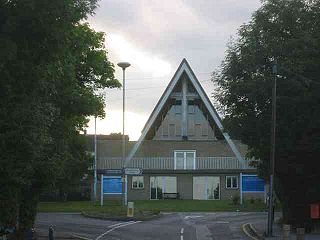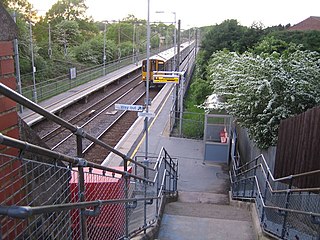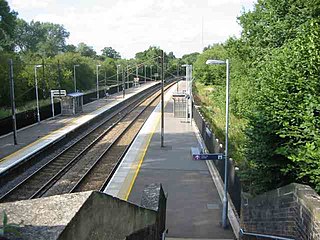
Hertfordshire is a ceremonial county in the East of England and one of the home counties. It borders Bedfordshire to the north-west, Cambridgeshire to the north-east, Essex to the east, Greater London to the south and Buckinghamshire to the west. The largest settlement is Watford, and the county town is Hertford.

Thameslink is a mainline route on the British railway network, running from Bedford, Luton, St Albans City, Peterborough, Welwyn Garden City, London Blackfriars and Cambridge via central London to Sutton, Orpington, Sevenoaks, Rainham, Horsham, Three Bridges, Brighton and East Grinstead. The network opened as a through service in 1988, with severe overcrowding by 1998, carrying more than 28,000 passengers in the morning peak. All the services are currently operated by Govia Thameslink Railway. Parts of the network, from Bedford to Three Bridges, run 24 hours a day, except on early Sunday mornings and during maintenance periods.

The London Borough of Enfield is a London borough in North London. It borders the London boroughs of Barnet to the west, Haringey to the south, and Waltham Forest to the southeast. To the north are the districts of Hertsmere, Welwyn Hatfield and Broxbourne, and to the east is Epping Forest District in Essex. The local authority is Enfield London Borough Council. Enfield's population is estimated to be 333,794; the main towns in the borough are Edmonton, Enfield, Southgate and Palmers Green. Enfield is the northernmost London borough.

Enfield is a large town in north London, England, 10.1 miles (16.3 km) north of Charing Cross. It had a population of 156,858 in 2018. It includes the areas of Botany Bay, Brimsdown, Bulls Cross, Bullsmoor, Bush Hill Park, Clay Hill, Crews Hill, Enfield Highway, Enfield Lock, Enfield Town, Enfield Wash, Forty Hill, Freezywater, Gordon Hill, Grange Park, Hadley Wood, Ponders End, and World's End.

Hertford is the county town of Hertfordshire, England, and is also a civil parish in the East Hertfordshire district of the county. The parish had a population of 26,783 at the 2011 census.

The East Coast Main Line (ECML) is a 393-mile long (632 km) electrified railway between its southern terminus at London King's Cross station and Edinburgh Waverley via Peterborough, Doncaster, York, Darlington, Durham and Newcastle. The line is a key transport artery on the eastern side of Great Britain running broadly parallel to the A1 road. The main line acts as a 'spine' for several diverging branches, serving destinations such as Cambridge, Leeds, Hull, Sunderland and Lincoln, all with direct services to London. In addition, a few ECML services extend beyond Edinburgh to serve Glasgow Central, although the principal London-Glasgow route is the West Coast Main Line (WCML).

Enfield Chase railway station is located in Windmill Hill, Enfield, in the London Borough of Enfield, north London, 9 miles 9 chains from London King's Cross on the Hertford Loop Line. It is in Travelcard Zone 5.

Palmers Green railway station, in Aldermans Hill, is in the London Borough of Enfield in north London, located within Travelcard Zone 4. It is 6 miles 50 chains on the line from London King's Cross. The station and all trains serving it are operated by Great Northern.

Winchmore Hill railway station is on Station Road, Winchmore Hill in the London Borough of Enfield in North London, England, in Travelcard Zone 4. It is 7 miles 63 chains down the line from London King's Cross on the Hertford Loop Line. The station, and all trains serving it are operated by Great Northern. Originally, upon opening in 1871, the station building was almost identical to that at neighbouring Palmers Green. However, in 1965 the northbound side of the building was demolished due to subsidence. In the 1970s the station boasted, on its southbound platform, a small newsagent and sweet shop, just beyond the base of the stairs down to the platform, but by 1980 this shop had been dismantled.

Grange Park railway station is situated just off The Grangeway, Grange Park in the London Borough of Enfield, north London, in Travelcard Zone 5. It is 8 miles 35 chains down the line from London King's Cross on the Hertford Loop Line. The station and all trains serving it are operated by Great Northern. Although located on the original 1871 route between Wood Green and Enfield, this station opened in 1910 at the same time as the line was extended northwards from Enfield to Cuffley.

Gordon Hill railway station serves Gordon Hill in the London Borough of Enfield, north London. It is 9 miles 69 chains down the line from London King's Cross on the Hertford Loop Line, in Travelcard Zone 5. It was opened on 4 April 1910. The station and the trains serving it are currently operated by Great Northern.

Cuffley railway station serves the village of Cuffley in the Welwyn Hatfield district of Hertfordshire. It also serves other nearby settlements, namely Goffs Oak, Northaw and the west of Cheshunt. It is 13 miles 17 chains down the line from London King's Cross on the Hertford Loop Line.

The Lea Valley lines are two commuter lines and two branches in north-east London, so named because they run along the Lower Lea Valley of the River Lea. They were part of the Great Eastern Railway, now part of the Anglia Route of Network Rail.

Cuffley is a village in the civil parish of Northaw and Cuffley, in the Welwyn Hatfield district of south-east Hertfordshire located between Cheshunt and Potters Bar. It has a population of just over 4,000 people. and is part of Broxbourne parliamentary constituency.

Stevenage railway station serves the town of Stevenage in Hertfordshire, England. The station is around 44.4 kilometres north of London King's Cross on the East Coast Main Line. Stevenage is served and managed by Great Northern, who operate Thameslink stopping services southbound to King’s Cross via stations such as Welwyn Garden City and Potters Bar, to Brighton and Horsham via central London and Gatwick Airport and to Moorgate via Watton-at-Stone, Hertford North and Enfield Chase and services northbound to Cambridge and Peterborough. It is also frequently served by London North Eastern Railway, who operate fast non-stopping services southbound towards London and northbound towards cities including York, Leeds and Edinburgh. Hull Trains and Lumo operate very limited services from the station.

Hertford North railway station is one of two stations serving the town of Hertford in Hertfordshire, England, the other being Hertford East railway station.

Watton-at-Stone railway station serves the village of Watton-at-Stone in Hertfordshire, England. It is 23 miles 72 chains down the line from London King's Cross on the Hertford Loop Line between Hertford North and Stevenage and is served by trains operated by Great Northern.

Bayford railway station serves the villages of Bayford and Brickendon in Hertfordshire, England. The station is on the Hertford Loop Line, 16 miles 56 chains down the line from London King's Cross.

The Great Northern route, formerly known as Great Northern Electrics, is the name given to suburban rail services run on the southern end of Britain's East Coast Main Line and its associated branches. Services operate to or from London King's Cross and London Moorgate. Destinations include Hertford North, Welwyn Garden City, Stevenage, and Cambridge, and in peak hours, additional services run to Peterborough and King's Lynn. Services run through parts of Greater London, Hertfordshire, Bedfordshire, Cambridgeshire, and Norfolk.

Cuffley Brook is a tributary of Turkey Brook. It runs through parts of Hertfordshire and the London Borough of Enfield, England. After the confluence of the two streams in Whitewebbs Park, the watercourse continues eastwards as Turkey Brook to join the River Lea near Enfield Lock.























